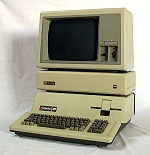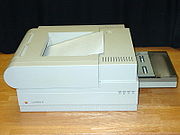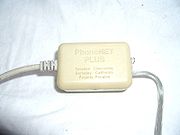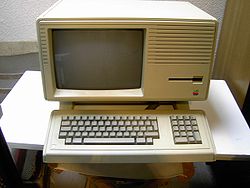
Macintosh Office
Encyclopedia
The Macintosh Office was Apple's third failed attempt to enter into the business environment as a serious competitor to IBM
. Consisting of three key parts, a network
file server
, local area network
and a network Laser printer
, Apple announced Macintosh Office in January 1985 with an ill-fated, poorly received sixty-second television commercial, dubbed Lemmings
during the Super Bowl
.
 Following the success of the Apple II
Following the success of the Apple II
personal computer
, Apple first sought to enter into the lucrative professional business market with the Apple III
. A high-end computer with features geared toward the business professional, it suffered from many technical problems which plagued the system during most of its production run. As a result, Apple's reputation suffered and it lost any advantage it had entering into the business market – a full year prior to the introduction of the IBM PC
. Apple's second attempt was with the introduction of the revolutionary Lisa
which was a high-end computer aimed at the business community, based on the graphical user interface
that was to become the basis of the Macintosh
. Unfortunately it proved far too expensive and offered too few features for most businesses to justify the cost. A year later when the much less expensive Macintosh
debuted, Lisa's fate was sealed and a year later was discontinued following less than three years of poor sales. While Apple had a hit with the Macintosh, they still needed a way to make inroads into the professional world and the Mac was already being criticized as a toy by the business community.
 Fortunately, the Macintosh had been designed with a network chip built into it. With the right hardware and software, every Macintosh was ready to be interconnected and used in a cross-platform
Fortunately, the Macintosh had been designed with a network chip built into it. With the right hardware and software, every Macintosh was ready to be interconnected and used in a cross-platform
environment. Drawing on that background Apple set about developing its AppleTalk
network which was to be interconnected by low-cost LocalTalk
connectors. Armed with the proper networking hardware, Apple set about developing the other key pieces of its business suite.
 By January 1985 Apple was ready to launch the LocalTalk network which would allow a small office to inexpensively share its newly introduced LaserWriter
By January 1985 Apple was ready to launch the LocalTalk network which would allow a small office to inexpensively share its newly introduced LaserWriter
printer. But the dedicated file server was up to two years away. The networked hard disk was closer, but still over a year away. By early 1985, Apple did not even offer a hard drive that worked on the Macintosh, much less a networked one. Unfortunately, Apple's newly announced network could do little else but print. As a stopgap measure, Apple had re-branded the Lisa 2/10 as the Macintosh XL
and dropped the price substantially. With its built-in 10MB hard drive, greater RAM and Macintosh System emulation software MacWorks, the XL was positioned to act as the file server until Apple could develop the replacement. However, there was no file-sharing software to take advantage of the Macintosh XL. Nevertheless, based on the premise promised by the Macintosh Office, the Macintosh XL sold well at its reduced price, so well that Apple ran out of parts, forcing it to be discontinued long before the replacement network server was ready.
 In the meantime, third party developers working with Apple, such as Infosphere and Centram Systems West (later Sun Microsystems
In the meantime, third party developers working with Apple, such as Infosphere and Centram Systems West (later Sun Microsystems
) created AppleTalk-based file sharing applications called XL/Serve (later MacServe) and TOPS
respectively. The former was actually a hard disk sharing
application that allowed a remote client Mac to log onto a hard drive connected to the host Mac and work on a file. However, this arrangement meant that only one user could access the file volume at a time. Nevertheless it fulfilled one of the main features of the Macintosh Office: a networked hard drive. By contrast, TOPS was a true file sharing application. With TOPS a remote client could log onto a host Mac and access and work on any file simultaneously with another remote or the host user. In addition, TOPS did not require a dedicated host, rather every Mac could be a host, offering peer-to-peer file sharing
. What's more, TOPS was not limited to the Macintosh, but could also share files across platforms with IBM PCs. Both of these products, as well as others, helped fulfill Apple's announcement of the Macintosh Office.
 Nevertheless, none of the software available represented a unified solution fully supported by Apple. Following the early removal of the Macintosh XL, Apple finally delivered its first hard drive for the Macintosh. Nine months after announcing it, the Hard Disk 20
Nevertheless, none of the software available represented a unified solution fully supported by Apple. Following the early removal of the Macintosh XL, Apple finally delivered its first hard drive for the Macintosh. Nine months after announcing it, the Hard Disk 20
was a mere 20MB hard drive. Though a welcome addition, it was slow and delivered none of the promise of a network file server. Though third party products made good use of it, Apple would not offer another installment of the poorly implemented Macintosh Office for well over a year. Instead Apple canceled the UNIX-based Big Mac file-server concept and chose to focus on the next generation Macintosh II
.
In January 1987, Apple finally introduced its file sharing application AppleShare
. Together with a faster SCSI
hard drive, the Hard Disk 20SC
released 3 months earlier, Apple finally offered an officially supported unified, simple-to-use file sharing network. However, it failed to deliver on the promise of the initial announcement made 2 years earlier. At best, the Macintosh Office was a piecemeal solution run on relatively underpowered Macs, lacking many of the features offered by third-party applications before it. In fact, it would be almost 5 more years before AppleShare would offer peer-to-peer file sharing under System 7
. It would take four more months for the release of expandable Macs that could accommodate the growing industry standard, Ethernet
, and larger, faster built-in hard drives powerful enough to manage AppleTalk's potential to serve a large office. IBM network compatibility was still unavailable.
with the advent of the LaserWriter, the low-cost network interface which made it affordable and the resulting software developers who took advantage of the Macintosh GUI
and the printer's PostScript
professional looking output. More than anything this cemented Apple's reputation as a serious computer and its indispensable place in the office, particularly when compared to the capabilities of its DOS
based counterparts.
IBM
International Business Machines Corporation or IBM is an American multinational technology and consulting corporation headquartered in Armonk, New York, United States. IBM manufactures and sells computer hardware and software, and it offers infrastructure, hosting and consulting services in areas...
. Consisting of three key parts, a network
Computer network
A computer network, often simply referred to as a network, is a collection of hardware components and computers interconnected by communication channels that allow sharing of resources and information....
file server
File server
In computing, a file server is a computer attached to a network that has the primary purpose of providing a location for shared disk access, i.e. shared storage of computer files that can be accessed by the workstations that are attached to the computer network...
, local area network
Local area network
A local area network is a computer network that interconnects computers in a limited area such as a home, school, computer laboratory, or office building...
and a network Laser printer
Laser printer
A laser printer is a common type of computer printer that rapidly produces high quality text and graphics on plain paper. As with digital photocopiers and multifunction printers , laser printers employ a xerographic printing process, but differ from analog photocopiers in that the image is produced...
, Apple announced Macintosh Office in January 1985 with an ill-fated, poorly received sixty-second television commercial, dubbed Lemmings
Lemmings (television commercial)
Lemmings was a television commercial that launched the "Macintosh Office" by Apple Computer in the United States, in January 1985, a year after the introduction of the Apple Macintosh in 1984. It was aired during the 1985 Super Bowl...
during the Super Bowl
Super Bowl
The Super Bowl is the championship game of the National Football League , the highest level of professional American football in the United States, culminating a season that begins in the late summer of the previous calendar year. The Super Bowl uses Roman numerals to identify each game, rather...
.
History

Apple II
The Apple II is an 8-bit home computer, one of the first highly successful mass-produced microcomputer products, designed primarily by Steve Wozniak, manufactured by Apple Computer and introduced in 1977...
personal computer
Personal computer
A personal computer is any general-purpose computer whose size, capabilities, and original sales price make it useful for individuals, and which is intended to be operated directly by an end-user with no intervening computer operator...
, Apple first sought to enter into the lucrative professional business market with the Apple III
Apple III
The Apple III is a business-oriented personal computer produced and released by Apple Computer that was intended as the successor to the Apple II series, but largely considered a failure in the market. Development work on the Apple III started in late 1978 under the guidance of Dr. Wendell Sander...
. A high-end computer with features geared toward the business professional, it suffered from many technical problems which plagued the system during most of its production run. As a result, Apple's reputation suffered and it lost any advantage it had entering into the business market – a full year prior to the introduction of the IBM PC
IBM PC
The IBM Personal Computer, commonly known as the IBM PC, is the original version and progenitor of the IBM PC compatible hardware platform. It is IBM model number 5150, and was introduced on August 12, 1981...
. Apple's second attempt was with the introduction of the revolutionary Lisa
Apple Lisa
The Apple Lisa—also known as the Lisa—is a :personal computer designed by Apple Computer, Inc. during the early 1980s....
which was a high-end computer aimed at the business community, based on the graphical user interface
Graphical user interface
In computing, a graphical user interface is a type of user interface that allows users to interact with electronic devices with images rather than text commands. GUIs can be used in computers, hand-held devices such as MP3 players, portable media players or gaming devices, household appliances and...
that was to become the basis of the Macintosh
Macintosh
The Macintosh , or Mac, is a series of several lines of personal computers designed, developed, and marketed by Apple Inc. The first Macintosh was introduced by Apple's then-chairman Steve Jobs on January 24, 1984; it was the first commercially successful personal computer to feature a mouse and a...
. Unfortunately it proved far too expensive and offered too few features for most businesses to justify the cost. A year later when the much less expensive Macintosh
Macintosh 128K
The Macintosh 128K machine, released as the "Apple Macintosh", was the original Apple Macintosh personal computer. Its beige case contained a monitor and came with a keyboard and mouse. An indentation in the top of the case made it easier for the computer to be lifted and carried. It had a selling...
debuted, Lisa's fate was sealed and a year later was discontinued following less than three years of poor sales. While Apple had a hit with the Macintosh, they still needed a way to make inroads into the professional world and the Mac was already being criticized as a toy by the business community.
Strategy

Cross-platform
In computing, cross-platform, or multi-platform, is an attribute conferred to computer software or computing methods and concepts that are implemented and inter-operate on multiple computer platforms...
environment. Drawing on that background Apple set about developing its AppleTalk
AppleTalk
AppleTalk is a proprietary suite of protocols developed by Apple Inc. for networking computers. It was included in the original Macintosh released in 1984, but is now unsupported as of the release of Mac OS X v10.6 in 2009 in favor of TCP/IP networking...
network which was to be interconnected by low-cost LocalTalk
LocalTalk
LocalTalk is a particular implementation of the physical layer of the AppleTalk networking system from Apple Computer. LocalTalk specifies a system of shielded twisted pair cabling, plugged into self-terminating transceivers, running at a rate of 230.4 kbit/s...
connectors. Armed with the proper networking hardware, Apple set about developing the other key pieces of its business suite.
- It would include a dedicated file server they code-named Big Mac. Essentially it was conceived as a fast UnixUnixUnix is a multitasking, multi-user computer operating system originally developed in 1969 by a group of AT&T employees at Bell Labs, including Ken Thompson, Dennis Ritchie, Brian Kernighan, Douglas McIlroy, and Joe Ossanna...
-based server which ran the Mac OSMac OSMac OS is a series of graphical user interface-based operating systems developed by Apple Inc. for their Macintosh line of computer systems. The Macintosh user experience is credited with popularizing the graphical user interface...
as an interface shellShell (computing)A shell is a piece of software that provides an interface for users of an operating system which provides access to the services of a kernel. However, the term is also applied very loosely to applications and may include any software that is "built around" a particular component, such as web...
. - Also included was a networked hard drive intended to be plugged directly into the network.
- Finally, a Laser printer which would produce typeset quality documents also shared among all the users on the network.

LaserWriter
The LaserWriter was a laser printer with built-in PostScript interpreter introduced by Apple in 1985. It was one of the first laser printers available to the mass market...
printer. But the dedicated file server was up to two years away. The networked hard disk was closer, but still over a year away. By early 1985, Apple did not even offer a hard drive that worked on the Macintosh, much less a networked one. Unfortunately, Apple's newly announced network could do little else but print. As a stopgap measure, Apple had re-branded the Lisa 2/10 as the Macintosh XL
Macintosh XL
Macintosh XL was a modified version of the Apple Lisa personal computer made by Apple Computer, Inc. In the Macintosh XL configuration, the computer shipped with MacWorks XL, a Lisa program that allowed 64 K Macintosh ROM emulation...
and dropped the price substantially. With its built-in 10MB hard drive, greater RAM and Macintosh System emulation software MacWorks, the XL was positioned to act as the file server until Apple could develop the replacement. However, there was no file-sharing software to take advantage of the Macintosh XL. Nevertheless, based on the premise promised by the Macintosh Office, the Macintosh XL sold well at its reduced price, so well that Apple ran out of parts, forcing it to be discontinued long before the replacement network server was ready.

Sun Microsystems
Sun Microsystems, Inc. was a company that sold :computers, computer components, :computer software, and :information technology services. Sun was founded on February 24, 1982...
) created AppleTalk-based file sharing applications called XL/Serve (later MacServe) and TOPS
TOPS (file server)
TOPS is a peer-to-peer LAN-based file sharing system best known in its Macintosh implementation, but also available for Windows and able to interoperate with Unix's NFS. Originally written by Centram Systems West, the company was purchased by Sun Microsystems as part of Sun's development of the...
respectively. The former was actually a hard disk sharing
Shared resource
In computing, a shared resource or network share is a device or piece of information on a computer that can be remotely accessed from another computer, typically via a local area network or an enterprise Intranet, transparently as if it were a resource in the local machine.Examples are shared file...
application that allowed a remote client Mac to log onto a hard drive connected to the host Mac and work on a file. However, this arrangement meant that only one user could access the file volume at a time. Nevertheless it fulfilled one of the main features of the Macintosh Office: a networked hard drive. By contrast, TOPS was a true file sharing application. With TOPS a remote client could log onto a host Mac and access and work on any file simultaneously with another remote or the host user. In addition, TOPS did not require a dedicated host, rather every Mac could be a host, offering peer-to-peer file sharing
Peer-to-peer file sharing
P2P or Peer-to-peer file sharing allows users to download files such as music, movies, and games using a P2P software client that searches for other connected computers. The "peers" are computer systems connected to each other through internet. Thus, the only requirements for a computer to join...
. What's more, TOPS was not limited to the Macintosh, but could also share files across platforms with IBM PCs. Both of these products, as well as others, helped fulfill Apple's announcement of the Macintosh Office.

Hard Disk 20
The Macintosh Hard Disk 20 was the first hard drive developed by Apple Computer specifically for use with the Macintosh 512K. Introduced on September 17, 1985, it was part of Apple's long awaited solution toward completing the Macintosh Office announced in January 1985...
was a mere 20MB hard drive. Though a welcome addition, it was slow and delivered none of the promise of a network file server. Though third party products made good use of it, Apple would not offer another installment of the poorly implemented Macintosh Office for well over a year. Instead Apple canceled the UNIX-based Big Mac file-server concept and chose to focus on the next generation Macintosh II
Macintosh II
The Apple Macintosh II was the first personal computer model of the Macintosh II series in the Apple Macintosh line and the first Macintosh to support a color display.- History :...
.
In January 1987, Apple finally introduced its file sharing application AppleShare
AppleShare
AppleShare was a product from Apple Computer which implemented various network services. Its main purpose was acting as a file server, using the AFP protocol...
. Together with a faster SCSI
SCSI
Small Computer System Interface is a set of standards for physically connecting and transferring data between computers and peripheral devices. The SCSI standards define commands, protocols, and electrical and optical interfaces. SCSI is most commonly used for hard disks and tape drives, but it...
hard drive, the Hard Disk 20SC
Hard Disk 20SC
The Apple Hard Disk 20SC was Apple's first SCSI based hard drive for the Apple II family as well as the Macintosh and other third party computers using an industry standard SCSI interface.-History:Released...
released 3 months earlier, Apple finally offered an officially supported unified, simple-to-use file sharing network. However, it failed to deliver on the promise of the initial announcement made 2 years earlier. At best, the Macintosh Office was a piecemeal solution run on relatively underpowered Macs, lacking many of the features offered by third-party applications before it. In fact, it would be almost 5 more years before AppleShare would offer peer-to-peer file sharing under System 7
System 7
System 7 is the name of a Macintosh operating system introduced in 1991.System 7 may also refer to:* System 7 , a British dance/ambient band* System 7 , 1991 album* IBM System/7, a 1970s computer system...
. It would take four more months for the release of expandable Macs that could accommodate the growing industry standard, Ethernet
Ethernet
Ethernet is a family of computer networking technologies for local area networks commercially introduced in 1980. Standardized in IEEE 802.3, Ethernet has largely replaced competing wired LAN technologies....
, and larger, faster built-in hard drives powerful enough to manage AppleTalk's potential to serve a large office. IBM network compatibility was still unavailable.
Legacy
Though largely considered a failure by most, The Macintosh Office ushered in the era of Desktop PublishingDesktop publishing
Desktop publishing is the creation of documents using page layout software on a personal computer.The term has been used for publishing at all levels, from small-circulation documents such as local newsletters to books, magazines and newspapers...
with the advent of the LaserWriter, the low-cost network interface which made it affordable and the resulting software developers who took advantage of the Macintosh GUI
Gui
Gui or guee is a generic term to refer to grilled dishes in Korean cuisine. These most commonly have meat or fish as their primary ingredient, but may in some cases also comprise grilled vegetables or other vegetarian ingredients. The term derives from the verb, "gupda" in Korean, which literally...
and the printer's PostScript
PostScript
PostScript is a dynamically typed concatenative programming language created by John Warnock and Charles Geschke in 1982. It is best known for its use as a page description language in the electronic and desktop publishing areas. Adobe PostScript 3 is also the worldwide printing and imaging...
professional looking output. More than anything this cemented Apple's reputation as a serious computer and its indispensable place in the office, particularly when compared to the capabilities of its DOS
DOS
DOS, short for "Disk Operating System", is an acronym for several closely related operating systems that dominated the IBM PC compatible market between 1981 and 1995, or until about 2000 if one includes the partially DOS-based Microsoft Windows versions 95, 98, and Millennium Edition.Related...
based counterparts.

